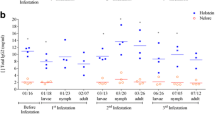Abstract
Antisera from guinea pigs made resistant to infestation with an ixodid tick of east and central Africa,Rhipicephalus appendiculatus, were used to identify the tick antigens they recognized by immunoblotting. Most of the antigens were found in tick salivary glands and in tick attachment cement. Antisera fromR. appendiculatus-resistant guinea pigs also recognized some salivarygland antigens in ticks of other species (R. pulchellus, R. evertsi, Amblyomma variegatum andA. gemma). Antibodies against the most strongly recognizedR. appendiculatus antigen, a 20-kDa molecule, were only poorly reactive with similar-sized molecules in the other ticks. A 94-kDa antigen, which appeared to have broader cross-reactivity, was purified fromR. appendiculatus attachment cement, and a monospecific rabbit serum was raised against it. This antiserum clearly recognized a molecule of similar molecular weight inR. pulchellus andR. evertsi. Intravenous inoculation of rabbits with the purified molecule elicited delayed-type hypersensitivity to the antigen. The hypersensitive rabbits demonstrated resistance to feeding ofR. appendiculatus ticks but slight enhanced feeding ofR. pulchellus ticks. These results are discussed with respect to their relevance for artificial induction of tick-feeding resistance.
Similar content being viewed by others
References
Ackerman, S., Floyd, M. and Sonenshine, D.E., 1980. Artificial immunity toDermacentor variabilis (Acari:Ixodidae): vaccination using tick antigens. J. Med. Entomol., 17:391–397.
Askenase, P.W., 1980. Immunopathology of parasitic diseases: involvement of basophils and mast cells. Springer Semin. Immunopathol., 2: 417–442.
Brown, S.J. and Askenase, P.W., 1986.Amblyomma americanum: physiochemical isolation of a protein derived from the tick salivary gland that is capable of inducing immune resistance in guinea pigs. Exp. Parasitol., 62: 40–50.
Brown, S.J., Graziano, F.M. and Askenase, P.W., 1982. Immune serum transfer of cutaneous basophil-associated resistance to ticks: mediation by 7SIgG1 antibodies. J. Immunol., 129: 2407–2412.
Brown, S.J., Shapiro, S.Z. and Askenase, P.W., 1984. Characterization of tick antigens inducing host immune resistance. I. Immunization of guinea pigs withAmblyomma americanum-derived salivary gland extracts and identification of an important salivary protein antigen with guinea pig anti-tick antibodies. J. Immunol., 133: 3319–3325.
Chiera, J.W., Newson, R.M. and Cunningham, M.P., 1985. Cumulative effects of host resistance onRhipicephalus appendiculatus Neumann (Acarina:Ixodidae) in the laboratory. Parasitology, 90: 401–408.
Den Hollander, N. and Allen, J.R., 1985.Dermacentor variabilis: acquired tick resistance in BALB/c mice. Exp. Parasitol., 59: 118–129.
Gregson, J.D., 1970. Antigenic properties of tick secretions. J. Parasitol., 56: 1038–1039.
Kemp, D.H., Stone, B.F. and Binnington, K.C., 1982. Tick attachment and feeding: role of the mouthparts, feeding apparatus, salivary gland secretions and the host response. In: F.D. Obenchain and R. Galun (Editors), Physiology of Ticks: Pergamon Press, Oxford, pp. 119–168.
Levine, B.D., Chang, H. Jr. and Vaz, N.M., 1971. The production of hapten-specific reagenic antibodies in the guinea pig. J. Immunol., 106: 29–33.
Nogge, G. and Giannetti, M., 1980. Specific antibodies: a potential insecticide. Science, 209: 1028–1029.
Shapiro, S.Z., Voigt, W.P. and Fujisaki, K., 1986. Tick antigens recognized by serum from a guinea pig resistant to infestation with the tickRhipicephalus appendiculatus. J. Parasitol., 72: 454–463.
Shapiro, S.Z., Buscher, G. and Dobbelaere, D.A.E., 1987. Acquired resistance toRhipicephalus appendiculatus (Acari:Ixodidae): identification of an antigen eliciting resistance in rabbits. J. Med. Entomol., 24: 147–154.
Tatchell, R.J., 1969. Host-parasite interactions and the feeding of blood-sucking arthropods. Parasitology, 59: 93–104.
Wikel, S.K. and Allen, J.R., 1982. Immunological basis of host resistance to ticks. In: F.D. Obenchain and R. Galun (Editors), Physiology of Ticks. Pergamon Press, Oxford, pp. 169–196.
Willadsen, P., 1980. Immunity to ticks. Adv. Parasitol., 18: 293–313.
Author information
Authors and Affiliations
Rights and permissions
About this article
Cite this article
Shapiro, S.Z., Voigt, W.P. & Ellis, J.A. Acquired resistance to ixodid ticks induced by tick cement antigen. Exp Appl Acarol 7, 33–41 (1989). https://doi.org/10.1007/BF01200451
Received:
Issue Date:
DOI: https://doi.org/10.1007/BF01200451




